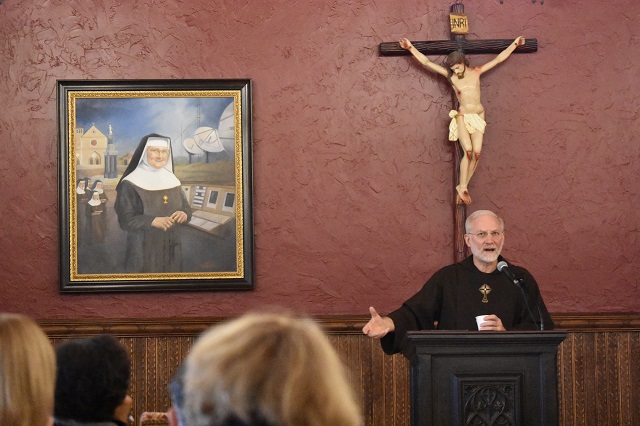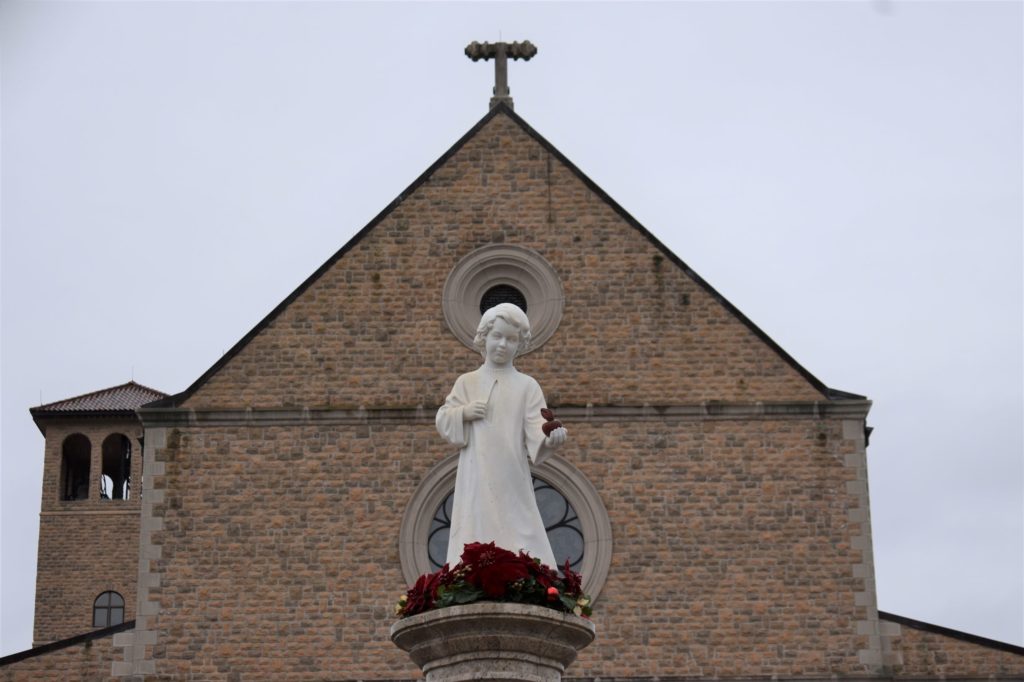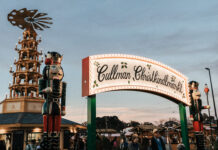
HANCEVILLE, Ala. – The Shrine of the Most Blessed Sacrament near Hanceville celebrated its 20th anniversary last week. The Shrine was officially dedicated and opened Dec. 19, 1999. During the Shrine’s Christmas Open House Saturday, Fr. Joseph Wolfe of the Franciscan Missionaries of the Eternal Word, which serve the Shrine and Eternal Word Television Network (EWTN), talked to guests about the origins and purpose of the international pilgrimage destination: a little about the hows and whens, but more about the whys.
The Shrine began as a monastery for Mother Angelica’s Poor Clares of Perpetual Adoration, whose previous cloister was located in the present headquarters of EWTN in Irondale. Seeking a location that was bigger, quieter and more conducive to contemplation, the sisters had $13,000 (raised through the sale of fishing lures) to spend on property when they located an isolated parcel of land at the end of a winding road in a bend of the Mulberry Fork in south Cullman County. According to Wolfe, the owner’s asking price was the exact amount the order had raised.
As construction crews broke ground in the red clay of a former soybean field on the site, they discovered an unexpected patch of white clay, and there Mother Angelica decided to build the monastery’s chapel that would become the Shrine church.
Her thought, according to Wolfe, was, “It was something symbolic- this was going to be something special; this was going to be a place where God was going to bless people, because shrines are really to be oases in the desert of the world. It’s to be a place where you come and you encounter God, and you’re given renewed strength for the journey of life, which isn’t always easy.
“You know, Mother said to me one time- we were here, she was looking toward the Temple, and she said, ‘You know, that place is to be a place where people come and they encounter the Lord.’ They meet the Lord. We preserve silence there. We only have the morning Mass, typically, up there. The rest of the day is silent adoration. But it’s preserved for people just to enter into silence.”
Citing writings of Cardinal Robert Sarah, Wolfe explained, “We live in such a noisy world, and we fill our heads with so much noise, and we need that silence to be able to hear the voice of God. That’s preserved upstairs where people can just go there.”
Two miles of white fence
The first thing visitors notice when they approach the Shrine is a long stretch of mostly undeveloped land on either side of the road, bounded by white fences.
Wolfe explained: “(Mother Angelica) wanted that 2 miles of white fence that you see as you come in. Originally, that wasn’t the property of the monastery, but Mother wanted a buffer, she called it, so that there wouldn’t just be buildings and noisy things, if you will, coming all the way up to the front gate, but that you had a sense that you’re coming to some place apart, that you can leave your troubles behind.
“She said to me once, ‘You know, the largeness of this place makes your problems seem smaller, because you’re here, you’re in the beauty of God’s creation, you’re in the beauty of His Church. That’s the place to encounter God.’
“The Castle (San Miguel) is to show us how to then go out and live our faith with courage like St. Joan of Arc, knowing that we have the angels like St. Michael to help us, and to have virtue and valor like the knights of old as we confront and struggle in the world we face today.
“So that 2 miles of white fence is a time just to enter into some place apart, some place distinct from our noisy lives and noisy world, where we can just come here and we can rest for a while and find rest for our souls and rest in the Lord’s presence. Just being in His presence is healing.”
Christmas year-round: the Creche
A small chapel projects from the side of a low man-made hill between Castle San Miguel and the Temple, inside of which is a nativity set like few have ever seen. A collection of well-known Fontanini figures, these differ from the norm by being made on a 50-inch scale, over half actual life size.
Wolfe told his audience, “Just around the corner you see that chapel there. (Mother Angelica) wanted, all year round, that there would be a life-size nativity scene so that we could always reflect on the incarnation. And again, the incarnation: with our human logic, our calculations, what’s-in-it-for-me kind of mentality, we can’t understand God doing such a thing. But if we think with the logic of love, like a Mother Teresa spending her life picking up the destitute out of the gutters, where does that love come from to do something like that? Maybe I can do it for a day or two, but for your whole life? But St. Therese, her patron, said, ‘Love stoops down to pick up.’ And when we see someone like Mother Teresa, we say, ‘Well, there’s some source greater than her for that love,’ and that love is from God. If we think with the logic of love, we can understand the incarnation. Mother wanted a life-size nativity scene, which is right through that window.”
The creche has a more recently added chapel because, according to Wolfe, “She wanted (visitors) to really reflect on the incarnation, that God had become man. And so, they added that chapel. You have a sense when you go in there, you’re going into a cave. She wanted the stone in the floor to come from the river that surrounds here, so they brought up that stone. Then you have Christmas music playing, singing of the incarnation.”
Colonnade and piazza
In front of the Temple stretches a large brick-paved public area that stretches out to the parking lot. Down either side, coming out from the Temple, is a colonnaded walkway, and in the center of the piazza directly in front of the Temple stands a statue of the Child Jesus holding what visitors sometimes mistake for an apple. The object, though, is a representation of what Catholics call the Sacred Heart of Jesus, held out in offering to Shrine pilgrims as they approach.
Wolfe said Mother Angelica feared noise and traffic approaching too near the Shrine, so she ordered, “‘There’s got to be a piazza here.’ So the colonnade, really, like St. Peter’s in Rome, is like two arms welcoming and embracing those who come there, and Jesus is holding out His heart to welcome all who come here.”
Wolfe shared Catholic teachings on the purposes of a religious shrine, including:
- Memory – Shrines preserve the memory of a historical event. For Mother Angelica and her sisters, the memory behind the Shrine was the Eucharist (Lord’s Supper for many Protestants), referred to by Catholics as the “most blessed sacrament,” and the coming of God as a child in the person of Jesus Christ. According to Mother Angelica, a vision of the Child Jesus at a shrine in South America led her to add a shrine to the plans for her Cullman County monastery.
- Prophecy – According to Wolfe, the beauty of the Shrine “is just a little glimpse of what the beauty of Heaven is going to be like. It’s a prophecy of what our true land is in Heaven; not just grasping for whatever we can get in this earth, but having this faith that can see farther, the much richer destiny that we have than whatever the earth could give us.”
- Presence – The Shrine is a place for administration of the Catholic Church’s sacraments, as well as a conference and spiritual retreat center, for days or just a few moments. According to Wolfe, “Mother said, ‘I want people to go there to experience His presence, to encounter the Lord, and to come here to the castle to be encouraged with new courage and valor like St. Joan of Arc, knowing that the angels like Michael are with us to help us in the struggles of life. And, having valor and courage like the knights of old, that we can go forward then, after we encounter the Lord here, we can go forward with new hope and new courage.’”
The happiest day of her life
Wolfe told his audience, “You know what Mother Angelica said was the happiest day of her life? The day this church was dedicated. Why? She said, ‘Because I could give something so beautiful to Him.’
“This whole place: a lot of blood, sweat and tears went into it, a lot of sacrifices; it was very demanding. It would have been a lot easier if Mother had said ‘No’ to that inspiration. But then, when that day came, she said it was the happiest day of her life, that she could give Him something so beautiful, the One who had given so much beauty to her life, that had taken her from being this teenager who was confused in a divorced home, with a physical problem, and reaching down into her life and revealing His love to her, so that now, she just wanted to love Him in return with everything she had. That’s what He had done for her: taken her out of that darkness and confusion, and the misery of that life that seemed to have no meaning or hope. She wondered if God existed, if He did, if He cared. And she experienced it. She was healed physically, but even in a deeper way in her heart.
“And the rest of her life was like, ‘I have to tell people. I have to tell others.’ And so, this Shrine, really, is pointing to that truth. If He is really present in the Blessed Sacrament in this unique way, profound way, that saints and people throughout history have understood and experienced, and were willing to sacrifice for, if He’s really present there, then it would make sense. And He is.”
Copyright 201 Humble Roots, LLC. All Rights Reserved.































